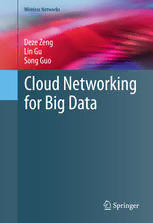
Cloud Networking for Big Data PDF
Preview Cloud Networking for Big Data
Wireless Networks Deze Zeng Lin Gu Song Guo Cloud Networking for Big Data Wireless Networks SeriesEditor XueminShermanShen UniversityofWaterloo Waterloo,Ontario,Canada Moreinformationaboutthisseriesathttp://www.springer.com/series/14180 Deze Zeng • Lin Gu (cid:129) Song Guo Cloud Networking for Big Data 123 DezeZeng LinGu ChinaUniversityofGeosciences HuazhongUniversityofScienceandTech Wuhan,Hubei,China Wuhan,Hubei,China SongGuo SchoolofComputerScience andEngineering TheUniversityofAizu Aizu-WakamatsuCity,Japan ISSN2366-1186 ISSN2366-1445 (electronic) WirelessNetworks ISBN978-3-319-24718-2 ISBN978-3-319-24720-5 (eBook) DOI10.1007/978-3-319-24720-5 LibraryofCongressControlNumber:2015952315 SpringerChamHeidelbergNewYorkDordrechtLondon ©SpringerInternationalPublishingSwitzerland2015 Thisworkissubjecttocopyright.AllrightsarereservedbythePublisher,whetherthewholeorpartof thematerialisconcerned,specificallytherightsoftranslation,reprinting,reuseofillustrations,recitation, broadcasting,reproductiononmicrofilmsorinanyotherphysicalway,andtransmissionorinformation storageandretrieval,electronicadaptation,computersoftware,orbysimilarordissimilarmethodology nowknownorhereafterdeveloped. Theuseofgeneraldescriptivenames,registerednames,trademarks,servicemarks,etc.inthispublication doesnotimply,evenintheabsenceofaspecificstatement,thatsuchnamesareexemptfromtherelevant protectivelawsandregulationsandthereforefreeforgeneraluse. Thepublisher,theauthorsandtheeditorsaresafetoassumethattheadviceandinformationinthisbook arebelievedtobetrueandaccurateatthedateofpublication.Neitherthepublishernortheauthorsor theeditorsgiveawarranty,expressorimplied,withrespecttothematerialcontainedhereinorforany errorsoromissionsthatmayhavebeenmade. Printedonacid-freepaper SpringerInternationalPublishingAGSwitzerlandispartofSpringerScience+BusinessMedia(www. springer.com) Preface The explosive growth of big data imposes a heavy burden on computation, stor- age, and communication resources in today’s infrastructure. To efficiently exploit the bulk cloud resources for big data processing, many different parallel cloud computingprogrammingframeworks,suchasApacheHadoop,Spark,andTwitter Storm, have been proposed and widely applied. However, all these programming paradigms mainly focus on data storage and computation, while still treating the communication issue as blackbox. How data are transmitted in the network is transparent to theapplication developers. Although such paradigm makes applica- tion development easy, an increasing concern to manipulate the data transmission in the network according to the application requirements emerges and asks for flexible, customizable, secure, and efficient networking control. The gap between the computation programming and communication programming shall be filled up. Fortunately, the recent development in some newly emerging technologies such as software-defined networking (SDN) and network function virtualization (NFV)stimulatescloudnetworkinginnovationtowardsbigdataprocessing.Weare motivatedtopresenttheconceptofcloudnetworkingforbigdatainthismonograph. Basedontheunderstandingofcloudnetworkingtechnology,wefurtherpresent twocasestudiestoprovidehigh-levelinsightsonhowcloudnetworkingtechnology can benefit big data application on the perspective of cost-efficiency. With the rising number of data centers all over the world, the electricity consumption and communication cost have been increasing drastically as the main operational expenditure (OPEX) to data centers. Therefore, cost minimization has become an emergent issue for data centers in big data era. Different from conventional cloud services, one of the main features of big data services is the tight coupling between data and computation as computation tasks can be conducted only when thecorrespondingdataisavailable.Asaresult,threefactors,i.e.,taskassignment, dataplacement,anddatamovement,deeplyinfluenceOPEXofgeo-distributeddata centers. Thanks to cloud networking, we are able to pursue cost minimization via jointoptimizationofthesethreefactorsforbigdataapplicationsingeo-distributed data centers. We first characterize the data processing procedure using a two- dimensionalMarkovchainandderivetheexpectedcompletiontimeinclosed-form, v vi Preface based on which the joint optimization is formulated as a mixed-integer nonlinear programming (MINLP) problem. To tackle the high computational complexity of solving our MINLP, we linearize it into a mixed-integer linear programming (MILP)problem.Experimentresultsshowthatourjoint-optimizationsolutionhas substantialadvantageovertheapproachbytwo-stepseparateoptimization. We further notice that processing large numbers of continuous data streams, i.e., big data stream processing (BDSP), has become a crucial requirement for many scientific and industrial applications in recent years. Public cloud service providersusuallyoperateanumberofgeo-distributeddatacentersacrosstheglobe. Different data center pairs are with different inter-data center network costs due to the different locations and distances. While inter-data center traffic in BDSP constitutes a large portion of a cloud provider’s traffic demand over the Internet andincurssubstantialcommunicationcost,whichmayevenbecomethedominant OPEX factor. As the data center resources are provided in a virtualized way, the virtual machines (VMs) for stream processing tasks can be freely deployed onto any data centers, provided that the service level agreement (SLA, e.g., quality- of-information) is obeyed. This raises the opportunity, but also a challenge, to exploretheinter-datacenternetworkcostdiversitytooptimizebothVMplacement and load balancing towards network cost minimization with guaranteed quality- of-information. Fortunately, cloud networking makes such optimization possible. We first propose a general modeling framework that can transform the VM placement into VM selection problem and describe all representative inter-task relationshipsemanticsinBDSP.Basedonournovelframework,wethenformulate thecommunicationcostminimizationproblemforBDSPintoaMILPproblemand proveittobeNP-hard.Wethenproposeacomputation-efficientsolutionbasedon MILP.Thehighefficiencyofourproposalisalsovalidatedbyextensivesimulation- basedstudies. Keywords: Cloud networking, Software-defined networking, Network function virtualization,Cloudcomputing,Geo-distributeddatacenters,Costefficiency,Big data,Resourcemanagementandoptimization. Waterloo,ON,Canada XueminShermanShen Wuhan,Hubei,China DezeZeng Wuhan,Hubei,China LinGu Aizu-WakamatsuCity,Japan SongGuo Acknowledgements WefirstwouldliketoexpressourheartfeltgratitudetoDr.Xuemin(Sherman)Shen, whoreviewedandofferedprofessionalandconstructivecommentstoimprovethis monograph. We are equally grateful to Susan Lagerstrom-Fife and Jennifer Malat who provided support in the process of editing. Without their generous help, this monograph would have been hardly possible. We also would like to thank all the readerswhoareinterestedinthisnewlyemergingareaandourmonograph.Lastbut not least: I beg forgiveness of all those who have helped a lot and whose names I havefailedtomention. vii Contents PartI NetworkEvolutionTowardsCloudNetworking 1 BackgroundIntroduction................................................... 3 1.1 NetworkingEvolution .................................................. 3 1.2 CloudComputing ....................................................... 8 1.2.1 InfrastructureasaService...................................... 9 1.2.2 PlatformasaService ........................................... 10 1.2.3 SoftwareasaService........................................... 10 1.3 BigData ................................................................. 11 1.3.1 BigDataBatchProcessing..................................... 13 1.3.2 BigDataStreamProcessing.................................... 14 1.4 Summary ................................................................ 15 References..................................................................... 15 2 FundamentalConcepts...................................................... 17 2.1 SoftwareDefinedNetworking.......................................... 17 2.1.1 Architecture..................................................... 17 2.1.2 Floodlight ....................................................... 19 2.1.3 OpenDaylight................................................... 20 2.1.4 RyuSDNFramework........................................... 20 2.2 NetworkFunctionVirtualization....................................... 21 2.2.1 NFVinDataCenters ........................................... 22 2.2.2 NFVinTelecommunications................................... 23 2.3 RelationshipBetweenSDNandNFV.................................. 23 2.4 BigDataBatchProcessing ............................................. 24 2.4.1 Hadoop.......................................................... 24 2.4.2 DIYAD .......................................................... 27 2.4.3 Spark ............................................................ 27 2.5 BigDataStreamProcessing............................................ 28 2.5.1 Storm............................................................ 29 2.5.2 HAMR .......................................................... 30 ix
